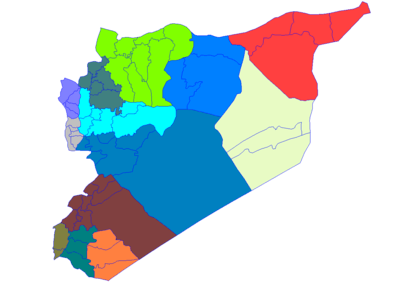Latakia
Latakia (Arabic: اللَّاذقِيَّة al-Lādhqīyah; Syrian pronunciation: [el.laːdˈʔɪjje, -laːðˈqɪjja]) is the principal port city of Syria, as well as the capital of the Latakia Governorate. Historically, it has also been known as Laodicea in Syria or Laodicea ad Mare. In addition to serving as a port, the city is a manufacturing center for surrounding agricultural towns and villages. According to the 2004 official census, the population of the city is 383,786,[4][5] Its population greatly increased as a result of the ongoing Syrian Civil War due to the influx of refugees from rebel held areas. It is the 4th-largest city in Syria after Aleppo, Damascus and Homs, and it borders Tartus to the south, Hama to the east, and Idlib to the north while Cape Apostolos Andreas, the most north-eastern tip of Cyprus is about 68 miles (109 km) away.[6]
Latakia اللاذقية | |
|---|---|
City | |
.jpg)   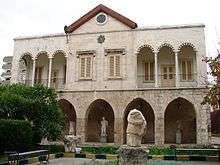 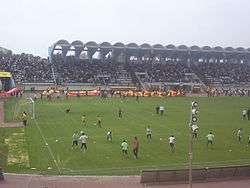  | |
 Seal | |
| Nickname(s): "Bride of the Mediterranean"[1] | |
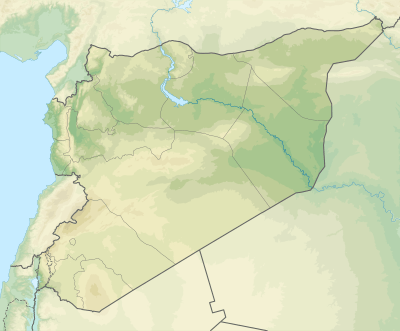 Latakia Location of Latakia within Syria 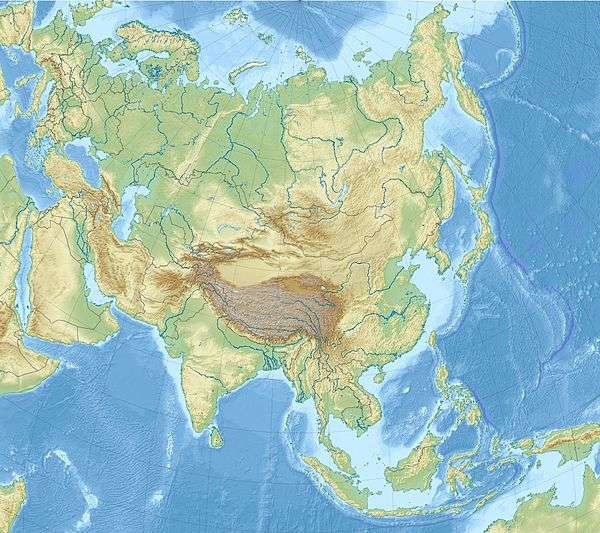 Latakia Latakia (Asia) | |
| Coordinates: 35°31′N 35°47′E | |
| Country | |
| Governorate | Latakia |
| District | Latakia |
| Subdistrict | Latakia |
| Government | |
| • Governor | Ahmad Sheikh Abdulqader[2] |
| Area | |
| • Land | 58 km2 (22 sq mi) |
| • Metro | 108 km2 (42 sq mi) |
| Elevation | 11 m (36 ft) |
| Population (2004 census) | |
| • City | 383,786[3] |
| • Metro | 424,392 |
| Demonym(s) | Arabic: لاذقاني, romanized: Lādhqani |
| Area code(s) | 41 |
| Geocode | C3480 |
| Climate | Csa |
| Website | eLatakia |
Although the site has been inhabited since the 2nd millennium BC, the city was founded in the 4th century BC under the rule of the Seleucid empire. Latakia was subsequently ruled by the Romans, then the Ummayads and Abbasids in the 8th–10th centuries of the Christian era. Under their rule, the Byzantines frequently attacked the city, periodically recapturing it before losing it again to the Arabs, particularly the Fatimids. Afterward, Latakia was ruled successively by the Seljuk Turks, Crusaders, Ayyubids, Mamluks, and the Ottomans. Following World War I, Latakia was assigned to the French mandate of Syria, in which it served as the capital of the autonomous territory of the Alawites. This autonomous territory became the Alawite State in 1922, proclaiming its independence a number of times until reintegrating into Syria in 1944.
Etymology
Like many Seleucid cities, Latakia was named after a member of the ruling dynasty.[7] First named Laodikeia on the Coast (Greek: Λαοδίκεια ἡ Πάραλος) by Seleucus I Nicator in honor of his mother, Laodice. In Latin, its name became Laodicea ad Mare. The original name survives in its Arabic form as al-Ladhiqiyyah (Arabic: اللاذقية), from which the French Lattaquié and English Latakia or Lattakia derive.[7][8] To the Ottomans, it was known as Lazkiye.
History
Ancient settlement and founding
The location of Latakia, the Ras Ziyarah promontory,[9][10] has a long history of occupation. The Phoenician city of Ramitha was located here.[11] Stephanus of Byzantium writes that the city was named Ramitha (Ancient Greek: Ῥάμιθα), then Leukê Aktê ("white coast") (Ancient Greek: Λευκὴ ἀκτή) and later Laodicea (Ancient Greek: Λαοδίκεια).[12]
The city was described in Strabo's Geographica:[13]
It is a city most beautifully built, has a good harbour, and has territory which, besides its other good crops, abounds in wine. Now this city furnishes the most of the wine to the Alexandreians, since the whole of the mountain that lies above the city and is possessed by it is covered with vines almost as far as the summits. And while the summits are at a considerable distance from Lāŏdĭcḗa, sloping up gently and gradually from it, they tower above Apameia, extending up to a perpendicular height.
Roman rule
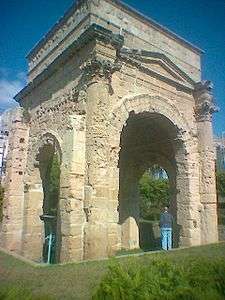
Pompey the Great conquered the city along with most of Syria in the 1st century BC, and Julius Caesar declared the city a "free polis." The Roman emperor Septimius Severus rewarded the city with the title of "Metropolis" in the 2nd century AD, exempted it of the empire's taxation, fortified the city, made it for a few years the capital of Roman Syria and also built the city's famed Tetraporticus around the same time. Some Roman merchants moved to live in the city under Augustus, but the city was always culturally "Greek" influenced. Subsequently, a Roman road was built from southern Anatolia toward Berytus and Damascus, that greatly improved the commerce through the port of Laodicea.
The heretic Apollinarius was bishop of Lāŏdĭcḗa in the 4th century. The city minted coins from an early date, but decreasing in importance after the cities of Alexandria and Antioch flourished in coin minting and overshadowed other cities.
The city was also famed for its wine produced around the port's hills which were exported to all the empire.
During the split of the Roman Empire, it belonged to the Eastern Roman Empire. An earthquake damaged the city in 494, but the city was later reconstructed by Justinian I and made the capital of the Eastern Roman province of Theodorias from 528 AD until Muslim conquest around 637 AD.

Early Islamic era
All of Syria, including the Roman province of Theodorias and its capital, Laodicea fell into Muslim rule after its attacked by a caliphate general, named 'Ubadah ibn al-Samit during the Muslim conquest of Syria in the 7th century. The city was renamed al-Lādhiqīyah (اللَّاذِقِيَّة) and switched rule from the Rashidun Caliphate, to the Umayyad Caliphate and finally to the Abbasid Caliphate in a span of 9 centuries, attached to the large province of Bilad Al-Sham (Greater Syria). Arab geographer, Al-Muqaddasi (d. 991), mentions al-Lādhiqīyah as belonging to the district of Hims (Homs).[14]
Crusader, Ayyubid, and Mamluk rule
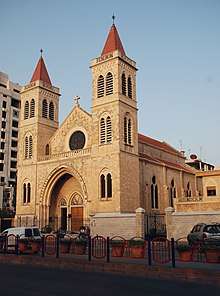
The Mardaites controlled the region from to Jebel Aqra to northern Palestine, including Latakia in 705. However, they later withdrew from the city after an agreement with the Umayyad caliph Al-Walid I. Afterwards, the Mardaites sacked it in 719, but it was rebuilt by Umar II. The city lost its importance due its location on the border between the Byzantine Empire and the Abbasid Caliphate from 750 to 968. The Byzantine Empire recaptured the city in 970 by John I Tzimiskes, but it was lost to the Fatimids in 980. The Banu Munqidh managed to control the city until they were succeeded by the Seljuks during the reign of Malik-Shah I in 1086, despite a brief Byzantine control in 1074. Later on, Guynemer of Boulogne raided the city on 19 August 1097, with 28 ships coming from Cyprus during the First Crusade. In 1098, Raymond of Saint-Gilles captured the city, with the Byzantine fleet presence; hence, the city became contested between the crusaders and the Byzantines who controlled Latakia and Baniyas in the meantime.[15]
After failed efforts by Bohemond I of Antioch to capture Latakia from the Byzantine Empire in 1099, and a brief control of the Genoese fleet in 1101, the city was taken in 1103 by forces under the command of Tancred of Hauteville, a veteran of the First Crusade and acting regent of the Principality of Antioch.[16] Following the defeat of Antiochene forces at the Battle of Harran in 1104, the city was reoccupied by the Byzantines led by Admiral Cantacuzenus,[17] however they would again lose the city. Despite a treaty in 1108 with Bohemond promising to return Latakia to the Byzantine Empire by 1110 it was firmly under the control of the Principality of Antioch,[18] as it was called "La Liche". In 1126, the cities of Latakia and Jabala were the dowry of Princess Alice, daughter of King Baldwin II of Jerusalem, who later donated a house in Latakia to the Knights Hospitaller, which became their main base in the region. In April 1136, the city was sacked by Emir Sawar ibn Aytakin, governor of Aleppo, then it was struck by the 1157 Hama earthquake and the 1170 Syria earthquake.[15]
This situation remained the same with the city serving as the primary port for the Principality until after the loss of Antioch itself to the Ayyubids, under the rule of Saladin on 23 July 1188. By 1260, the crusaders recaptured the city, until they were defeated by the Mamluks of Qalawun,[19] on 20 April 1287.
In circa 1300, Arab geographer al-Dimashqi noted that Latakia had no running water and that trees were scarce, but the city's port was "a wonderful harbor... full of large ships".[20] In 1332, the Moroccan traveller Ibn Battuta visited Latakia in his journeys.[21]
During the late 14th and 15th century, Venetians had a consul in Latakia, due to the trade of cotton and silk from Persia.[22] The city which was in despair was rebuilt after a visit by Qaitbay in 1477.
Ottoman rule

Latakia became under the Ottoman control after the Battle of Marj Dabiq in 1516.
In 1888, when Wilayat Beirut was established, Latakia became its northernmost town.[23]
In the Ottoman period, the region of Latakia became predominantly Alawi. The Turkmen also consisted a significant minority. The city itself, however, contained significant numbers of Sunni and Christian inhabitants. The landlords in the countryside tended to be Sunni and Orthodox Christians, while the peasants were mostly Alawi. Like the Druzes, who also had a special status before the end of World War I, the Alawis had a strained relationship with the Ottoman overlords. In fact, they were not even given the status of millet, although they enjoyed relative autonomy.[24]
French Mandate period
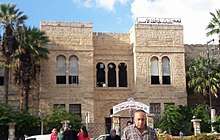
In 1920, Latakia fell under the French mandate, under which the Alawite State was established. The state was named after the locally-dominant Alawites, and became a French mandate territory after World War I.[25] The French Mandate from the League of Nations began in 1920.[26] The creation of the Alawite State as well as the other states of Syria under the French Mandate and the division it created was because the French hoped to focus on fragmenting the various groups in the region, so that the local population would not focus on the larger nationalist movement seeking to end colonial rule. Whatsoever, the French justified the creation of the Alawite state by citing the "backwardness" of the mountain-dwellers, religiously distinct from the surrounding Sunni population, and claimed that the division intended to protect the Alawi people from more-powerful majorities.[27]

The division the French administration created in Syria didn't stop Alawites such as Sheikh Saleh al-Ali, who led the Syrian Revolt of 1919, to continue and protest French rule. Saleh al-Ali coordinated with the leaders of other anti-French revolts in the country, including the revolt of Ibrahim Hananu in the Aleppo countryside and Subhi Barakat's revolt in Antioch, but Saleh al-Ali's revolt was put down in 1921, and a French court-martial in Latakia sentenced Shaykh Saleh to death in absentia, and offered a reward of 100,000 francs for information on his whereabouts. After the French gave up trying to capturing Shaykh Saleh, a pardon was issued by General Henri Gouraud.
The state became part of the Syrian Federation in 1922, but left the federation again in 1924. In 1930 the Alawite State was renamed as the Government of Latakia, the only concession by the French to Arab nationalists until 1936. On 3 December 1936 (becoming effective in 1937), the Alawite state was re-incorporated into Syria as a concession by the French to the Nationalist Bloc (the ruling party of the semi-autonomous Syrian government).[28]
There was a great deal of Alawite separatist sentiment in the region, but their political views could not be coordinated into a unified voice. There was also a great deal of factionalism amongst the Alawite tribes, and the Alawite State was incorporated into Syria with little organised resistance.
In 1942, the Latakia and Druze regions were returned to Syrian control, and by 1946, the French completely left Syria and a new independent government was created.
Modern era
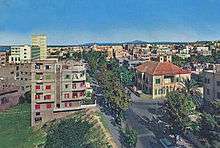
All but a few classical buildings have been destroyed, often by earthquakes; those remaining include a Roman triumphal arch and Corinthian columns known as the Colonnade of Bacchus.[29] However, important remains from the city at Roman and Hellenistic periods including full body statues, Roman funerary art, and column capitals that once belonged to the ancient city, are found in its national museum.
An extensive port project was proposed in 1948, and construction work began on the Port of Latakia in 1950, aided by a US$6 million loan from Saudi Arabia. By 1951, the first stage of the construction was completed, and the port handled an increasing amount of Syria's overseas trade.
In August 1957, 4,000 Egyptian troops landed in Latakia under orders from Gamal Abdel Nasser after Turkish troops massed along the border with Syria, accusing it of harboring Turkish Communists.[30]
A major highway linked Latakia with Aleppo and the Euphrates valley in 1968 and was supplemented by the completion of a railway line to Homs. The port became even more important after 1975, due to the troubled situation in Lebanon and the loss of Beirut and Tripoli as ports.[31]
In 1973, during the October War (Yom Kippur War), the naval Battle of Latakia between Israel and Syria was fought just offshore from Latakia. The battle was the first to be fought using missiles and ECM (electronic countermeasures).[32]
In 1987, the city hosted the tenth round of the Mediterranean Games, with the opening ceremony hosted by Hafez al-Assad in the Latakia Sports City, a sports complex designed specifically to host the games, with the Latakia Sports City Stadium serving as the main venue for the games.[33]
In 1994, the city's population reached 303,000, with that number significantly rising to 383,786 in 2004.[4] Although population assessment in recent years have become difficult due to the ongoing civil war, the city's population is estimated to have rose drastically due to the influx of refugees from the cities of Aleppo, Idlib and other cities held by rebels and extremist terrorists which have been affected by the ongoing war.
Syrian Civil War
During the Syrian Civil War, Latakia had been a site of protest activity since March 2011. The Syrian government claimed 12 were killed there in clashes in late March,[34] leading to the deployment of the military to restrict movement into and out of the city. Hundreds of Syrians were reportedly arrested, and by late July, activists in Latakia were telling foreign media they feared a more violent crackdown was coming. Protests continued despite the increased security presence and arrests. Several civilians were allegedly killed in confrontations with security officers during this early period of the siege.[35] On 13 August 2011, the Syrian Army and Syrian Navy launched an operation where more than 20 tanks and APCs rolled into the Alawi stronghold.[36] The city was also attacked by the Syrian army on the 14 August 2011. Activists claimed that 25 people died during the attack.[37]
.jpg)
Latakia is the home of Russia's largest foreign electronic eavesdropping facility.[38] Khmeimim Air Base is an airbase near Latakia converted to use by the Russian military in 2015.
The city has been relatively calm and secure during the civil war, with electricity and water returning as of 2017, and Russian air force constantly patrolling the city and surrounding localities.
In November 2016, al-Manara university, a private university, was founded in the city under the patronage of the Syrian Prime Minister, Imad Khamis and Syrian First Lady Asma al-Assad.[39] Its faculties as of 2017 include Pharmacy and Health, Engineering and Business.[40]
In September 2017, following the Syrian Arab Army's lift of ISIL's 3 year long siege over the city of Deir ez-Zor and the entire liberation of the city and surrounding villages in a successful offensive, 125 tons of citrus were sent in convoys from Latakia as a gift to the people of the city to celebrate the breaking of the devastating siege, with many more batches to be sent to the surrounding localities.[41]
Russian president Vladimir Putin, accompanied by his Syrian counterpart Bashar al-Assad visited the Khmeimim airbase, Russia's main military base in Syria, located just outside Latakia near Jableh on 11 December 2017.[42] Declaring victory over ISIL, and announcing a partial military withdrawal from Syria, but with continuing Russian presence, as the Khmeimim airbase and the Russian naval facility in Tartus would still be operated by Russian forces.[43]
In celebration of Christmas and the New Year, forces from the Khmeimim-based Russian Coordination Center distributed school bags, stationery and milk to the children of fallen soldiers in the Ghassan Zwan School and to the children of the Russian community in Latakia and the surrounding countryside.[44]
Geography
Latakia is located 348 kilometres (216 mi) north-west of Damascus, 186 kilometres (116 mi) south-west from Aleppo, 186 kilometres (116 mi) north-west of Homs, and 90 kilometres (56 mi) north of Tartus.[45] Nearby towns and villages include Kasab to the north, Al-Haffah, Slinfah and Qardaha to the east in the Coastal Mountain Range, and Jableh and Baniyas to the south.
Latakia is the capital of the Latakia Governorate, in western Syria, bordering Turkey to the north. The governorate has a reported area of either 2,297 square kilometres (887 sq mi)[46] or 2,437 square kilometres (941 sq mi).[47] Latakia is the administrative centre of the Latakia District that occupies the northern portion of the Latakia Governorate.
Nahr al-Kabir al-Shamali flows into the Mediterranean Sea south of Latakia.
Climate
Under Köppen's climate classification, Latakia has a hot-summer Mediterranean climate (Csa).[48] Latakia's wettest months are December and January, where average precipitation is around 160 mm. The city's driest month, July, only has on average about 1 millimetre (0.039 in) of rain, despite being rather humid. Average high temperatures in the city range from around 16 °C (61 °F) in January to around 30 °C (86 °F) in August. Latakia on average receives around 760 millimetres (30 in) of rainfall annually.
| Climate data for Latakia (1961–1990, extremes 1928–present) | |||||||||||||
|---|---|---|---|---|---|---|---|---|---|---|---|---|---|
| Month | Jan | Feb | Mar | Apr | May | Jun | Jul | Aug | Sep | Oct | Nov | Dec | Year |
| Record high °C (°F) | 24.4 (75.9) |
26.3 (79.3) |
32.6 (90.7) |
35.6 (96.1) |
38.8 (101.8) |
38.4 (101.1) |
36.2 (97.2) |
38.4 (101.1) |
38.2 (100.8) |
39.0 (102.2) |
32.6 (90.7) |
28.0 (82.4) |
39.0 (102.2) |
| Average high °C (°F) | 15.4 (59.7) |
16.4 (61.5) |
18.3 (64.9) |
21.5 (70.7) |
24.1 (75.4) |
25.8 (78.4) |
28.8 (83.8) |
29.6 (85.3) |
29.0 (84.2) |
26.3 (79.3) |
21.9 (71.4) |
17.6 (63.7) |
22.9 (73.2) |
| Daily mean °C (°F) | 11.6 (52.9) |
12.6 (54.7) |
14.8 (58.6) |
17.8 (64.0) |
20.7 (69.3) |
23.8 (74.8) |
26.3 (79.3) |
27.0 (80.6) |
25.6 (78.1) |
22.3 (72.1) |
17.5 (63.5) |
13.3 (55.9) |
19.4 (66.9) |
| Average low °C (°F) | 8.4 (47.1) |
9.1 (48.4) |
11.0 (51.8) |
14.0 (57.2) |
17.0 (62.6) |
20.7 (69.3) |
23.7 (74.7) |
24.3 (75.7) |
21.9 (71.4) |
18.2 (64.8) |
13.8 (56.8) |
10.1 (50.2) |
16.0 (60.8) |
| Record low °C (°F) | −1.6 (29.1) |
−0.5 (31.1) |
−0.6 (30.9) |
3.9 (39.0) |
10.6 (51.1) |
11.7 (53.1) |
17.8 (64.0) |
17.2 (63.0) |
12.4 (54.3) |
8.9 (48.0) |
0.0 (32.0) |
0.0 (32.0) |
−1.6 (29.1) |
| Average precipitation mm (inches) | 185.2 (7.29) |
97.0 (3.82) |
91.5 (3.60) |
48.5 (1.91) |
22.4 (0.88) |
5.2 (0.20) |
1.3 (0.05) |
2.3 (0.09) |
8.0 (0.31) |
69.3 (2.73) |
95.5 (3.76) |
185.2 (7.29) |
811.4 (31.94) |
| Average precipitation days (≥ 1.0 mm) | 11.3 | 9.3 | 8.4 | 4.6 | 2.7 | 1.0 | 0.3 | 0.3 | 1.0 | 5.2 | 6.6 | 11.0 | 61.7 |
| Average relative humidity (%) | 63 | 62 | 65 | 68 | 72 | 74 | 74 | 73 | 68 | 62 | 57 | 65 | 67 |
| Mean monthly sunshine hours | 136.4 | 148.4 | 198.4 | 225.0 | 297.6 | 321.0 | 325.5 | 316.2 | 288.0 | 248.0 | 192.0 | 151.9 | 2,848.4 |
| Mean daily sunshine hours | 4.4 | 5.3 | 6.4 | 7.5 | 9.6 | 10.7 | 10.5 | 10.2 | 9.6 | 8.0 | 6.4 | 4.9 | 7.8 |
| Source 1: NOAA[49] | |||||||||||||
| Source 2: Deutscher Wetterdienst (humidity, 1966–1978),[50] Meteo Climat (record highs and lows)[51] | |||||||||||||
| Climate data for Latakia (1966–2004) | |||||||||||||
|---|---|---|---|---|---|---|---|---|---|---|---|---|---|
| Month | Jan | Feb | Mar | Apr | May | Jun | Jul | Aug | Sep | Oct | Nov | Dec | Year |
| Average high °C (°F) | 15.6 (60.1) |
16.3 (61.3) |
18.4 (65.1) |
21.5 (70.7) |
24.2 (75.6) |
26.8 (80.2) |
28.9 (84.0) |
29.7 (85.5) |
29.0 (84.2) |
26.8 (80.2) |
22.1 (71.8) |
17.3 (63.1) |
23.05 (73.49) |
| Average low °C (°F) | 8.4 (47.1) |
9.0 (48.2) |
10.9 (51.6) |
14.0 (57.2) |
17.1 (62.8) |
20.9 (69.6) |
24.0 (75.2) |
24.5 (76.1) |
22.1 (71.8) |
18.4 (65.1) |
13.7 (56.7) |
10.0 (50.0) |
16.08 (60.94) |
| Average precipitation mm (inches) | 162.6 (6.40) |
99.8 (3.93) |
90.6 (3.57) |
44.2 (1.74) |
21.0 (0.83) |
4.5 (0.18) |
0.9 (0.04) |
4.5 (0.18) |
7.8 (0.31) |
67.1 (2.64) |
95.2 (3.75) |
160.7 (6.33) |
758.9 (29.88) |
| Average precipitation days (≥ 1.0 mm) | 13 | 17 | 11 | 7 | 4 | 1 | 0 | 1 | 2 | 6 | 8 | 13 | 83 |
| Source: WMO[52] | |||||||||||||
Demographics
.jpg)
| Year | Pop. | ±% |
|---|---|---|
| 1905 | 25,000[53] | — |
| 1932 | 24,000[54] | −4.0% |
| 1943 | 36,000[54] | +50.0% |
| 1957 | 56,000[54] | +55.6% |
| 1970 | 126,000[54] | +125.0% |
| 1987 | 241,000[54] | +91.3% |
| 1992 | 284,000[55] | +17.8% |
| 1994 | 303,000[54] | +6.7% |
| 2004 | 383,786[3] | +26.7% |
One of the first censuses was in 1825, which recorded that there were 6,000–8,000 Muslims, 1,000 Greek Orthodox Christians, 30 Armenian Christians, 30 Maronite Catholics, and 30 Jews.[56] At the beginning of the 20th century, Latakia had a population of roughly 7,000 inhabitants; however, the Journal of the Society of Arts recorded a population of 25,000 in 1905.[53] In a 1992 estimate, Latakia had a population of 284,000,[55] rising to 303,000 in the 1994 census.[54] The city's population continued to rise, reaching an estimated 402,000 residents in 2002.[57]
Latakia was historically a Sunni city, however the Alawatization process under Hafez al Asaad led to many Alawites moving from the rural hinterland into the city. In 2010 Latakia City was 50% Alawite, 40% Sunni and 10% Christian,[58] however, the rural hinterland has an Alawite majority of roughly 70%, with Christians making up 14%, Sunni Muslims making up 12%, and Ismailis representing the remaining 2%. The city serves as the capital of the Alawite population and is a major cultural center for the religion.[57] Throughout the 1980s and 1990s, large numbers of Alawites from the area emigrated to the country's capital Damascus.[59] Of the Christians, a sizable Antiochian Greek population exists in Latakia, and their diocese in the city has the largest congregation of the Greek Orthodox Church of Antioch.[60][61][62] There is also an Armenian community of 3,500 in the city.[62][63] The entire population speaks Arabic, mostly in the North Levantine dialect.[64]
Within the city boundaries is the "unofficial" Latakia camp, established in 1956, which has a population of 6,354 Palestinian refugees, mostly from Jaffa and the Galilee.[65]
Economy

.jpg)
The Port of Latakia (Arabic: ميناء اللاذقية) is the main seaport in Syria. It was established on the 12th of February, 1950, and has boosted the city's importance ever since. The port's imported cargo include clothing, construction materials, vehicles, furniture, minerals, tobacco, cotton, and food supplies such as lintels, onions, wheat, barley, dates, grains and figs, and in 2008, the port handled about 8 million tons of cargo.
The largest area of the port with 43 hectares occupies the container terminal. The storage capacity is up to 17,000 containers.[66] Latakia was connected to six ferry lines to Alexandria (Egypt), Izmir (Turkey) and Beirut (Lebanon). It is not known whether the lines still exist in the Syrian civil war, which has been going on since 2011.
The marina Latakia has 150 berths for ships up to a maximum length of 25 meters and 4 meters draught.[67] The Syrian Navy has one of four bases in Latakia.
Latakia has an extensive agricultural hinterland. Exports include bitumen (asphalt), cereals, cotton, fruits, eggs, vegetable oil, pottery, and tobacco. Cotton ginning, vegetable-oil processing, tanning, and sponge fishing serve as local industries for the city.[29]
The Cote d'Azur Beach of Latakia is Syria's premier coastal resort, and offers water skiing, jet skiing, and windsurfing. The city contains eight hotels, two of which have five-star ratings; both the Cote d'Azur de Cham Hotel and Lé Meridien Lattiquie Hotel are located 6 kilometres (3.7 mi) north of the city, at Cote d'Azur. The latter hotel has 274 rooms and is the only international hotel in the city.[68]
Compared to other Syrian cities, window shopping and evening strolls in the markets is considered a favorite pastime in Latakia. Numerous designer-label stores line 8 Azar Street, and the heart of the city's shopping area is the series of blocks enclosed by 8 Azar Street, Yarmouk Street, and Saad Zaghloul Street in the city center. Cinemas in Latakia include Ugarit Cinema, al-Kindi, and a smaller theater off al-Moutanabbi Street.[69]
Culture
Festivals
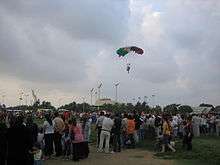
Museums
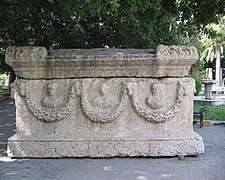
The National Museum of Latakia was built in 1986 near the seafront of the city. It formerly housed the residence of the Governor of the Alawite State and was originally a 16th-century Ottoman khan ("caravansary") known as Khan al-Dukhan, meaning "The Khan of Smoke", as it served the tobacco trade. The khan historically served not only as an inn, but also contained private residences.[60] The exhibits include inscribed tablets from Ugarit, ancient jewellery, coins, figurines, ceramics, pottery, and early Arab and Crusader-era chain-mail suits and swords.[70][71]
However, since the outbreak of the Syrian Civil War in 2011, the museum had been temporarily closed, to protect the museum's exhibits from the trafficking and looting, which became common during recent years, that the Museums of Palmyra, Deir ez-Zor and Raqqa suffered from. However, the museum's gardens are still open to the public, and contain many column capitals, ornaments, funerary tombs and statues which still can be viewed by the public.
Sport
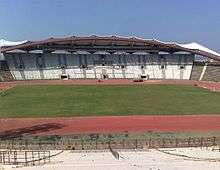
Latakia is the home city of three football clubs: Teshrin Sports Club was founded in 1947,[72] Hutteen Sports Club was founded in 1945.[73] and Tadamon SC was founded in 1980. All teams are based in the al-Assad Stadium, which carries a capacity of 28,000 people. Just north of the city is the Latakia Sports City complex, which was built in 1987 to host the 1987 Mediterranean Games.[74]
Latakia tobacco
Latakia tobacco is a specially prepared tobacco originally produced in Syria and named after the port city of Latakia.[75] Now the tobacco is mainly produced in Cyprus. It is cured over a stone pine or oak wood fire, which gives it an intense smokey-peppery taste and smell. Rarely smoked straight, it is used as a "condiment" or "blender" (a basic tobacco mixed with other tobaccos to create a blend), especially in English, Balkan, and some American Classic blends.[75]
Education

The University of Latakia was founded in May 1971, and later renamed Tishreen University ("October University") in 1976 to commemorate the October War of 1973. The university first had only 3 faculties, Literature, Science and Agriculture and only an enrollment of 983 students during its founding,[76] but that number largely grew throughout the years to reach more than 70,000 students,[76] making the Tishreen University the 3rd largest in Syria, with the number of its faculties rising to 17, including Medicine, Pharmacy, Dentistry, Science, Nursing, Education, Agriculture, Law, History, Electrical and Technical Engineering and Arts, among others. The city also houses a branch of the Arab Academy for Science and Technology and Maritime Transport.[29]
One of the oldest schools in Latakia, a previous military barracks built during the French Mandate of Syria and Lebanon is named after Jules Jammal, an Arab Christian military officer who blew himself up in a suicide attack on a French ship.[77]
On 26 November 2016, al-Manara University, a private university, was founded under the patronage of Imad Khamis, the Prime Minister of Syria.[78] Its faculties as of 2017 include Pharmacy and Health, Engineering and Business.[79]
Local infrastructure
Landmarks
The modern city still exhibits faint traces of its former importance, notwithstanding the frequent earthquakes with which it has been visited. The marina is built upon foundations of ancient columns, and there are in the town an old gateway and other antiquities, as also sarcophagi and sepulchral caves in the neighbourhood. This gateway is a remarkable triumphal arch at the southeast corner of the town, almost entire: it is built with four entrances, like the Forum Jani at Rome. It is conjectured that this arch was built in honour of Lucius Verus, or of Septimius Severus.[80] Fragments of Greek and Latin inscriptions are dispersed all over the ruins, but entirely defaced.
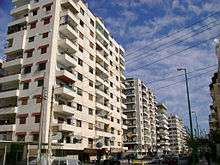
Notable points of interest in the nearby area include the massive Saladin's Castle and the ruins of Ugarit, where some of the earliest alphabetic writings have been found. There are also several popular beaches. There are numerous mosques in Latakia, including the 13th-century Great Mosque and the 18th-century Jadid Mosque constructed by Suleiman Pasha Azem.[60]
Latakia has consulates general of Finland and France, and honorary consulates of Greece and Romania.
Healthcare
The Syrian government operates three major public hospitals in Latakia, Al-Assad Hospital, The National Hospital and The Tishreen University Hospital, with other private hospitals working for private gain. one of the famous hospitals is bahrou hospital.
Transportation
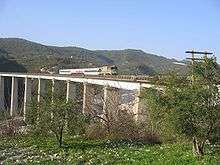

Roads link Latakia to Aleppo, Beirut, Homs, and Tripoli.[29] The main commercial coastal road of the city is Jamal Abdel Nasser Street, named after former Egyptian president Gamal Abdel Nasser. Lined with hotels, restaurants and the city museum, the street begins in central Latakia along the Mediterranean coast and ends at Hitteen Square. From the square, it branches southwest into al-Maghreb al-Arabi Street,[81] south into 8 Azar Street, which continues south to form Baghdad Avenue—the main north–south road[82]—branching into Beirut Street and Nadim Hassan Street along the southern coastline. From the southern portion of Jamal Abdel Nasser Street branch off al-Yarmouk Street and al-Quds Street, the latter which ends at al-Yaman Square in western Latakia, it continues west into Abdel Qader al-Husseini Street. North from al-Yaman Square Souria Avenue and south of the square is al-Ourouba Street. Souria Avenue ends in al-Jumhouriah Square, then continues north as al-Jumhouriah Street.[81]
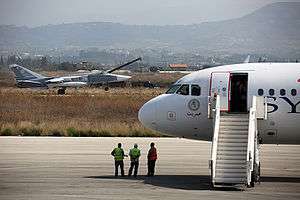
Much of the city is accessible by taxi and other forms of public transportation. Buses transport people to various Syrian, Lebanese, and Turkish cities, including Aleppo, Damascus, Deir ez-Zor, Palmyra, Tripoli, Beirut, Safita, Hims, Hama, Antakya, and Tartous. The "luxury" Garagat Pullman Bus Station is located on Abdel Qader al-Husseini Street, and at least a dozen private companies are based at the station. On the same street is the older Hob-Hob Bus Station that operates a "depart when full" basis to Damascus and Aleppo. Local microbuses run between al-Yaman Square and the city center, as well as between the station on al-Jalaa Street and the city center. There is also a microbus station with buses departing to Qalaat Salah ed-Din, Qardaha, Kassab, and Jableh.[69]
Latakia's railway station is located on al-Yaman Square. Chemins de Fer Syriens operated services, including two daily runs to Aleppo and one weekly run to Damascus via Tartous. In 2005, approximately 512,167 passengers departed from Latakia's railway station.[83]
The Bassel Al-Assad International Airport is located 25 kilometers (16 mi) south of Latakia and serves as a national and regional airport with regular flights to Sharjah, Jeddah, Riyadh and Cairo. The Port of Latakia is also a link in six organized cruises between Alexandria, İzmir and Beirut. In addition, there are irregular ferry services to Cyprus. In 2005, approximately 27,939 passengers used the port.[83]
International relations
Twin towns – Sister cities
See also
- List of cities in Syria
- List of notable people from Latakia
References
- Hamsa. "Meshquita; treasure trove of sparkling springs and lush forests". syriatimes.sy. Archived from the original on 2 January 2018. Retrieved 27 March 2018.
- H. Zain / Mazen / H. Sabbagh (23 April 2011). "New Governor of Lattakia sworn in". Syrian Arab News Agency. Archived from the original on 26 April 2011. Retrieved 23 April 2011.
- Latakia city population Archived 2013-03-17 at the Wayback Machine
- "Archived copy". Archived from the original on 2013-03-17. Retrieved 2012-06-20.CS1 maint: archived copy as title (link)
- City population size reported at "World-Gazetteer.com". Archived from the original on 2013-02-10. and similarly reported by CityPopulation.de.
- "Archived copy". Archived from the original on 2016-10-11. Retrieved 2016-07-29.CS1 maint: archived copy as title (link)
- le Strange, 1890, p.380.
- Ball, 2000, p.157
- "Ras Ziyarah", literally, "Cape of Visitation (Ziyarah)"
- National Geospatial-intelligence Agency (2005). Prostar Sailing Directions 2005 Eastern Mediterranean Enroute. ProStar Publications. p. 38. ISBN 9781577856573.
- La Boda 1994, p. 451.
- Stephanus of Byzantium, Ethnica, §L411.7
- Strabo (1857), The Geography of Strabo, p. 164, ISBN 978-0-521-85306-4
- Al-Muqaddasi, The Best Divisions for Knowledge of the Regions (Being a translation of "Ahsan al-Taqasim fi Maʿrifat al-Aqalim"), Reading 1994, p. 141 ISBN 1-873938-14-4
- La Boda 1994, p. 453.
- Thomas Asbridge, The Crusades: The War for the Holy Land, (London: Simon & Schuster, 2010), pp.137–138.
- Steven Runciman (1951). A History of the Crusades. Vol II: The Kingdom of Jerusalem, p. 37. ISBN 978-0-241-29876-3.
- Thomas Asbridge, The Crusades: The War for the Holy Land, (London: Simon & Schuster, 2010), pp.137–144.
- Thomas Asbridge, The Crusades: The War for the Holy Land, (London: Simon & Schuster, 2010), p.637.
- al-Dimashqi quoted in le Strange, 1890, p.491.
- The adventures of Ibn Battuta, a Muslim traveler of the fourteenth century By Ross E. Dunn, University of California Press. pp.137.
- Ashtor 2014, p. 121.
- Dumper, 2007, p.84
- Rabinovich, 1979, p.694
- Cahoon, Ben. "Syria". worldstatesmen.org. Retrieved 27 March 2018.
- Provence, Michael. "The Great Syrian Revolt and the Rise of Arab Nationalism." Austin: University of Texas Press, 2005.
- Longrigg, Stephen Hemsley. "Syria and Lebanon Under French Mandate." London: Oxford University Press, 1958.
- Shambrook, Peter A. "French Imperialism in Syria, 1927–1936." Reading: Ithaca Press, 1998.
- Latakia. (2009). In Encyclopædia Britannica. Retrieved 2009-03-01, from Encyclopædia Britannica Online.
- Podeh 1999, pp. 43
- Ring, 1994, p.455
- Betts, Richard K. (1982), Cruise Missile: Technology, Strategy and Politics, Brookings Institution Press, p. 381, ISBN 978-0-8157-0931-2
- "موقع اللاذقية – مدينة "الأسد" الرياضية...متنفس واسع لأهل المدينة وزوارهم". esyria.sy. Retrieved 27 March 2018.
- "Twelve killed in Saturday's Latakia protests, presidential adviser says". NOW Lebanon. 27 March 2011. Archived from the original on 14 August 2011. Retrieved 15 August 2011.
- "SYRIA: Protesters in Lattakia brave security forces". The Los Angeles Times. 25 July 2011. Retrieved 15 August 2011.
- "Syrian army 'enters western coastal city'". Al Jazeera English. 13 August 2011. Retrieved 13 August 2011.
- "Syrian 'warships shell port city of Latakia'". Al Jazeera. 14 August 2011.
- Russian military presence in Syria poses challenge to US-led intervention The Guardian, 2012-12-23.
- "125 Tons of Citrus sent from Lattakia to the people of Deir ez-Zor – Syrian Arab News Agency". Syrian Arab News Agency. 25 November 2017. Retrieved 25 December 2017.
- "Vladimir Putin makes triumphant visit to Syria airbase", The Guardian, 11 December 2017
- "On visit to Syria, Putin lauds victory over ISIS and announces withdrawals", The Washington Post, 11 December 2017
- "School supplies and milk distributed to martyrs' children and Russian community in Lattakia – Syrian Arab News Agency", Syrian Arab News Agency, 29 December 2017
- Distance Between Main Syrian Cities, HomsOnline, 2008-05-16, retrieved 2009-02-26
- Syria, citypopulation.de, 2008, retrieved 2009-08-10
- Provinces of Syria, Statoids, 2005, retrieved 2009-08-10
- http://www.hydrol-earth-syst-sci.net/11/1633/2007/hess-11-1633-2007.pdf
- "Latakia Climate Normals 1961–1990". National Oceanic and Atmospheric Administration. Retrieved April 26, 2017.
- "Klimatafel von Lattakia / Syrien" (PDF). Baseline climate means (1961–1990) from stations all over the world (in German). Deutscher Wetterdienst. Retrieved April 26, 2017.
- "Station Lattakia" (in French). Meteo Climat. Retrieved April 26, 2017.
- "Lattakia Climatological Information". World Meteorological Organization. Retrieved June 25, 2017.
- Society of Arts (Great Britain), 1906, p.556.
- Winckler, 1998, p.72.
- Latakia, Damascus-Online, archived from the original on December 31, 2009, retrieved 2009-07-29
- American Board of Commissioners for Foreign Missions, 1825, p.375.
- Minahan, 2002, p.79.
- "Latakia Is Assad's Achilles Heel". washingtoninstitute.org. Retrieved 27 March 2018.
- Dumper, 2007, pp.126–127.
- Latakia Come to Syria.
- Fahlbusch and Bromiley, 2008, p.279.
- Relations with Syria: The Greek community, Greek Ministry of Foreign Affairs, 2008, archived from the original on May 7, 2008, retrieved 2009-02-26
- The Armenian Prelacy in Aleppo, Periotem, archived from the original on 2011-07-15, retrieved 2009-03-01
- Minahan, 2002, p.80.
- Latakia:Unofficial Refugee Camp, UNRWA, 30 June 2002, retrieved 12 July 2007
- Port of Lattakia. World Port Source
- Carter, 2004, p.146.
- Mannheim, 2001, pp.290–291.
- Carter, 2008, p.146.
- Historical Sites of Latakia Archived 2006-03-29 at Archive.today Syria Gate.
- Teshrin SC Welt Fussball Archive.
- Al-Hutteen SC Welt Fussball Archive.
- Latakia Sports City Archived 2010-06-19 at the Wayback Machine Archnet Digital Library.
- A Tale of Two Latakias, G. L. Pease Tobaccos, 2008, retrieved 2009-07-29
- admm (19 June 2010). "عن الجامعة". tishreen.edu.sy. Archived from the original on 13 December 2017. Retrieved 27 March 2018.
- AHMED FAWAZ La rencontre entre le Président et son second remonte à la fin des années quarante, sur les bancs du lycée Jules Jammal, dans la ville côtière de Lattaquié. Tous deux étaient membres du parti Baas. Cette rencontre n'était Le Nouvel Afrique Asie page 23
- "Al-Manara University opened in Lattakia – Syrian Arab News Agency". Syrian Arab News Agency. 27 November 2016. Retrieved 25 December 2017.
- "University in Brief – جامعة المنارة – Manara University". manara.edu.sy. Archived from the original on 21 April 2018. Retrieved 27 March 2018.
- Description of the East, vol. ii. p. 197.
- Mannehim, 2001, p.284.
- Carter, 2004, p.144.
- Transport, Latakia-city.gov.sy, 2008, archived from the original on 2011-10-06, retrieved 2009-03-10
- "Kardeў оehir Hamm". Afyon-bld.gov.tr. Retrieved 2020-05-29.
- Mersin, Latakia become sister cities Turkish Daily News. 2008-01-21.
- "The Syrian-Iranian Joint Supreme Committee meetings (in Arabic)". Alwehda Publications. 2009-03-08. Retrieved 2009-11-30.
Bibliography
- Ashtor, Eliyahu (2014), Levant Trade in the Middle Ages, Princeton University Press, ISBN 978-1-400-853168CS1 maint: ref=harv (link)
- Ball, Warwick (2000), Rome in the East: The Transformation of an Empire, Routledge, ISBN 9780415113762.
- Beattie, Andrew; Pepper, Timothy (2001), The Rough Guide to Syria, Rough Guides, ISBN 9781858287188
- Carter, Terry; Dunston, Lara; Humphreys, Andrew (2004), Syria & Lebanon, Lonely Planet, ISBN 9781864503333
- Carter, Terry; Dunston, Lara; Thomas, Amelia (2008), Syria & Lebanon, Lonely Planet, ISBN 9781741046090
- Dumper, Michael; Stanley, Bruce E.; Abu-Lughod, Janet L. (2007), Cities of the Middle East and North Africa: A Historical Encyclopedia, ABC-CLIO, ISBN 9781576079195.
- Fahlbusch, Erwin; Bromiley, Geoffrey William (2008), The Encyclopedia Of Christianity: Volume 5: Si-Z, Wm. B. Eerdmans Publishing, ISBN 9780802824172.
- La Boda, Sharon (1994), International Dictionary of Historic Places: Middle East and Africa, Taylor & Francis, ISBN 978-1-884-964039CS1 maint: ref=harv (link)
- Hamilton, H.C.; Falconer, W., eds. (1857), The Geography of Strabo, III, London: Henry G. Bohn.
- Maʻoz, Moshe; Yaniv, Avner; Gustav Heinemann Institute of Middle Eastern Studies (1986), Syria Under Assad: Domestic Constraints and Regional Risks, Taylor & Francis, ISBN 978-0-7099-2910-9.
- Mannheim, Ivan (2001), Syria & Lebanon Handbook: The Travel Guide, Footprint Travel Guides, ISBN 9781900949903
- Minahan, James (2002), Encyclopedia of the stateless nations: ethnic and national groups around the world, Greenwood Publishing Group, ISBN 9780313323843.
- Oxford Business Group (2006), Emerging Syria 2006, Oxford Business Group, ISBN 9781902339443.
- Podeh, Elie (1999), The Decline of Arab Unity: The Rise And Fall of the United Arab Republic, Sussex Academic Press, ISBN 978-1-84519-146-7
- Rabinovich, Itamar (1979), "The Compact Minorities and the Syrian State, 1918-45", Journal of Contemporary History, 14 (4): 693–712, doi:10.1177/002200947901400407
- Riley-Smith, Jonathan (2005), The Crusades: A History, Continuum International Publishing Group, ISBN 9780826472700.
- Ring, Trudy; Salkin, Robert M.; La Boda, Sharon (1994), International Dictionary of Historic Places, Taylor & Francis, ISBN 9781884964039.
- le Strange, Guy (1890), Palestine Under the Moslems: A Description of Syria and the Holy Land from A.D. 650 to 1500, Committee of the Palestine Exploration Fund, ISBN 978-0-404-56288-5.
- Society of Arts (Great Britain) (1906), Journal of the Society of Arts, 54, The Society.
- Winckler, Onn (1998), Demographic developments and population policies in Baʻathist Syria, Sussex Academic Press, ISBN 978-1-902210-16-2
External links
| Wikimedia Commons has media related to Latakia. |
| Wikivoyage has a travel guide for Latakia. |
- elatakia The First Complete website for Latakia news and services
- Latakia news and services (in Arabic)
- Tishreen University (in English and Arabic)
- Audio interview with Latakia resident about life in Latakia
- Pictures from 2009
- . Encyclopædia Britannica (11th ed.). 1911.

